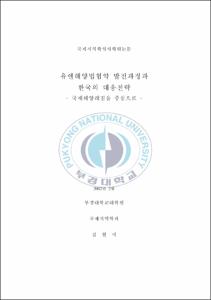유엔해양법협약 발전과정과 한국의 대응전략
- Alternative Title
- A Study on Development Process of UNCLOS and Korea's Strategies
- Abstract
- The UNCLOS is broad, far-reaching and reflective of the increasingly complex, interdependent nature of contemporary international relations. The law of the sea turned on two fundamental principles: (1) the territorial sea, or the right of a coastal state to control a narrow band of sea as extension of its sovereignty offshore; and (2) freedom of the high seas, meaning the freedoms of navigation and fishing in the high seas beyond that offshore coastal area. Those principles are intact and still active. Coming mainly since 1958, however, they have been augmented by a vast nexus of binding multilateral agreements that comprise the most sophisticated regulatory regime that governs comtemporary interstate relations.
The starting point for this analysis is the effort to codify the international ocean regime. The 1958 Geneva Conference marked a The conventions were promptly ratified by many countries, but soon came to be seen as insufficient. In particular, during the 1960s, the United Nations became increasingly concerned about the growing number of coastal states asserting control over vast reaches of the oceans. In 1973, negotiations were launched for a comprehensive Convention on the Law of the Sea(UNCLOS). In 1982, UNCLOS was adopted and came into effect in 1994. UNCLOS arranges and codifies the international ocean regime which is not unified and is troubled in spite of the international society's efforts. It has a meaning of establishing the new ocean regime unified the traditional ocean regimes which stand for the freedom of the sea and the sovereignty of the sea. It also has the meaning that it partially achieved a balance of ocean-related countries' complicated interest in its birth process as the standard created by countries' long consent process.
However, the balance of inter-countries' complicated interests and the reality of international society contains a possibility of change. It brings to conclusion that UNCLOS cannot perfectly reflect the international society's requirements changed by ocean-related all countries' interests and period.
The purpose of this study is to survey the international regime governing the use of ocean space by examining UNCLOS and to analyze the change of the international ocean regime from 17century to present, to comment the legal problems of UNCLOS with realistic views, and finally to develope the counterplan of Korean ocean policy on UNCLOS.
From the point of view, the regime governing the oceans has proliferated into a vast, complex network of International relations. This nexus of rules, regulations, principles and norms regulates the activities of national governments in their use of the sea in several dimensions, raging from efforts to ensure peaceful uses of the oceans, freedom of the sea, and territorial sea.
We need to keep up international political studies of the law of the sea. This kinds of study would have to be something over the approach to the political aspects of UNCLOS, and it would help Korean's ocean policy of the law of the sea. It will be an index to measure changes, development and diversity of UNCLOS through utilized international ocean regime.
- Issued Date
- 2007
- Awarded Date
- 2007. 2
- Type
- Dissertation
- Keyword
- 유엔해양법협약 국제해양레짐 한국해양정책 UNCLOS International Ocean Regime the law of the sea korean ocean Policy
- Publisher
- 부경대학교 대학원
- Alternative Author(s)
- Kim, Hyoun-Ji
- Affiliation
- 부경대학교 대학원
- Department
- 대학원 국제지역학과
- Advisor
- 이홍종
- Table Of Contents
- 제1장 서론 = 1
제1절 연구의 목적 = 1
제2절 연구범위와 방법 = 4
제2장 국제레짐의 이론적 고찰 = 6
제1절 국제레짐의 특성 = 6
1. 국제레짐의 정의 = 6
2. 국제레짐의 형성 및 촉진요인 = 9
제2절 국제레짐의 형성과 변화에 관한 이론 = 11
1. 자유주의적 접근 = 11
2. 현실주의적 접근 = 14
제3장 국제해양레짐의 생성과 발전 = 16
제1절 국제해양레짐의 개념과 등장배경 = 16
1. 국제해양레짐의 개념 = 16
1) 자유해양원칙 = 17
2) 연안국의 관할권 = 18
2. 국제해양레짐의 성립배경 = 19
제2절 국제해양레짐의 발전과정 = 23
1. 전통적 자유해양레짐:1920∼1945 = 23
2. 강력한 유사자유해양레짐:1945∼1966 = 25
3. 취약한 유사자유해양레짐 :1967∼1975 = 28
제3절 국제해양레짐의 성숙기 = 31
1. 제3차 유엔해양법회의와 유엔해양법협약 = 31
2. 유엔해양법협약의 주요내용 = 36
1) 영해 및 접속 수역 = 37
2) 국제해협의 통과통항제도 = 39
3) 군도수역제도 = 40
4) 배타적경제수역제도(EEZ:Exclusive Economic Zone) = 41
5) 대륙붕 = 42
6) 공해 및 심해저 = 43
7) 해양환경의 보호 및 보전 = 43
제4장 국제해양레짐으로서의 유엔해양법협약 = 46
제1절 유엔해양법협약의 국제레짐적 성격 = 46
제2절 국제해양레짐으로서 유엔해양법협약의 문제점 = 51
제3절 유엔해양법협약에 대한 한국의 대응전략 = 59
1. 영해 및 접속수역 문제 = 60
1) 직선기선제도 문제 = 60
2) 역사적 만에 대한 문제 = 61
2. 배타적경제수역제도 문제 = 63
1) 한일어업협정 문제 = 63
2) 해양경계획정 문제 = 64
3. 공해제도 문제 = 66
1) 공해어업제도 문제 = 66
2) 편의치적 문제 = 68
4. 심해저제도 문제 = 69
5. 해양환경의 보호 및 보전 문제 = 70
제5장 결론 = 73
참고문헌 = 77
- Degree
- Master
- Files in This Item:
-
-
Download
 유엔해양법협약 발전과정과 한국의 대응전략.pdf
기타 데이터 / 918.43 kB / Adobe PDF
유엔해양법협약 발전과정과 한국의 대응전략.pdf
기타 데이터 / 918.43 kB / Adobe PDF
-
Items in Repository are protected by copyright, with all rights reserved, unless otherwise indicated.